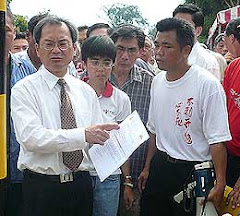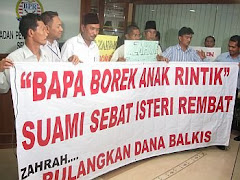 THE land on which the 113- year-old Pudu Prison is located has been identified as one of the major sites for mega development in the Draft KL City Plan 2020.
THE land on which the 113- year-old Pudu Prison is located has been identified as one of the major sites for mega development in the Draft KL City Plan 2020.The colonial era prison was taken over by the Urban Development Authority (UDA) in November 1996 after it was officially closed.
 First sight: The arch leading to the inner sanctum of the prison's X-shaped main block.
First sight: The arch leading to the inner sanctum of the prison's X-shaped main block.The land on which the prison structure stands has been earmarked for mixed development in the draft plan.
That means 70% of the land will be used for a commercial hub and 30% for residential development.
There are five plots involved in the proposed plan submitted by the UDA to the Kuala Lumpur City Hall (DBKL) in July 2005.
Plots 1, 2 and 5 are proposed for commercial buildings, including a 33-storey office tower, a shopping complex, a 43-storey hotel tower and a 44-storey serviced apartment tower.
 Familiar site: A look at the famous Pudu Prison mural and some of the buildings within the compound.
Familiar site: A look at the famous Pudu Prison mural and some of the buildings within the compound.The old prison mosque will be maintained while plots 3 and 4 will feature two blocks of 44-storey condominiums on each plot. There is also a 1.2ha park proposed in the plan.
The proposal also involves the widening of Jalan Pudu and making a new traffic way at Jalan Changkat Thamby Abdullah to create a dedicated entrance to the development site.
The Hang Tuah monorail station will also be integrated with the proposed development site to create easy accessibility for the public.
According to DBKL town planning director Mahadi Che Ngah, the proposed plan has been discussed by the town planning committee and examined by former mayor Datuk Ruslin Hasan when UDA submitted it in 2005.
 Infamous resident: A file picture of Botak Chin who served time and was executed at Pudu Prison.
Infamous resident: A file picture of Botak Chin who served time and was executed at Pudu Prison.However, due to the proposal’s high density, the UDA was told to scale down the development.
“At present, the traffic condition along Jalan Hang Tuah is already bad. The developers have to find a good solution to tackle the traffic problems,” Mahadi said.
 Hard work: Khong Yen Chong showing the award he received for painting the mural when he was an inmate at the prison in the 1980s.
Hard work: Khong Yen Chong showing the award he received for painting the mural when he was an inmate at the prison in the 1980s. “They can perhaps employ consultants to do traffic impact studies and make proposals on improving flow,” he said.
Mahadi said a major development with such a magnitude in Kuala Lumpur would enhance the confidence of local and foreign investors to invest in the city.
“In a way, if we do not propose this site for redevelopment, we are not encouraging other dilapidated properties in the city to be redeveloped by its owner. That kind of approach is not good for the city,” he said.
 Mahadi: UDA submitted a proposal to develop the area in 2005 but was told to scale it down.
Mahadi: UDA submitted a proposal to develop the area in 2005 but was told to scale it down.“If Kuala Lumpur is not booming who will want to come to the city?” Mahadi told StarMetro during an interview last week.
Mahadi said although the Pudu Prison was a well-known historical landmark in the city centre, its large area of 8.8ha should logically be capitalised in the city’s land development usage.
He said city development planning was always about striking a balance and there would always be a conflict in ideals and perception among various interest groups.
“But, as a city maker, we have to decide what is best for Kuala Lumpur by looking at benefits it has to offer,” Mahadi said.
“If there was a strong need to maintain part of the structure of the old prison building, then we would preserve it but probably not the entire site,” he said.
Mahadi said the UDA application status had lapsed since it was rejected for revision by City Hall.
“UDA was supposed to have come back to us within 30 days but it has been three years and there is no feedback from it on the plans. Based on our standard practice, the proposal is considered lapsed,” Mahadi said.













